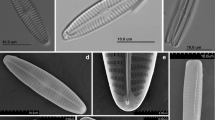Abstract
Biodegradation rates of 25 narcotic industrial chemicals were determined manometrically using resting cells prepared from preacclimated microorganisms. Chemical concentrations that would reduce maximum rates by 50% (BIC50) were estimated from rate inhibition data. Subsequently, the BIC50 and acute toxicities of chemicals to daphnids, barnacle larvae, copepods and fish (bleak, fathead minnow and golden orfe) were correlated. The r2 andF-statistics for all six linear correlations were significant (α = 0.001). This suggests, for chemicals having a non-specific mode of toxic action, the biodegradation inhibition test may be used to estimate concentrations which would be toxic to higher aquatic organisms. A comparison of toxicity data showed microorganisms were less sensitive to test chemicals than the other species.
Similar content being viewed by others
References
Bengtsson B, Renberg L, Tarkpea M (1984) Molecular structure and aquatic toxicology-an example with C1–C13 aliphatic alcohols. Chemosphere 13:613–622
Berkowitz D (1979) Potential uses of bacteria in toxicology. Vet Hum Toxicol 21:422–426
Bulich AA (1979) Use of Luminescent Bacteria for Determining Toxicity in Aquatic Environment. In: Marking LL, Kimerle AA (eds) Aquatic Toxicology-Second Conference, ASTM STP 667 American Society for Testing and Materials, Philadelphia, PA, pp 98–106
Bulich AA, Greene MM, Isenberg DL (1981) Reliability of the Bacterial Luminescence Assay for Determination of the Toxicity of Pure Compounds and Complex Effluents. In: Branson DR, Dickson KL (eds) Aquatic Toxicology and Hazard Assessment-Fourth Conference, ASTM STP 737 American Society for Testing and Materials, Philadelphia, PA, pp 338–347
Bulich AA, Isenberg DL (1980) Use of the luminescent bacterial system for the rapid assessment of aquatic toxicology. Adv Instrum 35:35–40
Crisp DJ, Christie AO, Ghobasky AFA (1967) Narcotic and toxic action of organic compounds on barnacle larvae. Comp Biol Physiol 22:629–645
Curtis C, Lima A, Lozano S, Veith G (1982) An evaluation of a bacterial bioluminescence bioassay as a method for predicting acute toxicity of organic chemicals to fish. In: Pearson Q, Foster RB, Bishop WE (eds) Aquatic Toxicology and Hazard Assessment, ASTM STP 766 American Society for Testing and Materials, Philadelphia, PA, pp 170–178
Dixon M, Webb EC, Thorne CJR, Tipton KE (1979) Enzymes. Academic Press, New York
Herbert D, Phipps PJ, Strange RE (1971) Chemical Analysis of Microbial Cells. In: Noms JR, Ribbons DW (eds) Methods in Microbiology. Academic Press, New York, pp 209–344
Hermens J, Busser F, Leeywangh P, Musch A (1985) Quantitative structure-activity relationships and mixture toxicity of organic chemicals inPhotobacterium phosphoreum: the Microtox test. Ecotoxicol Environ Safety 9:17–25
Hermens J, Canton H, Janssen P, De-Jong R (1984) Quantitative structure-activity relationships and toxicity studies of mixtures of chemicals with anesthetic potency: acute lethal and subacute toxicity toDaphnia magna. Aquat Toxicol 5:143–154
Indorato AM, Snyder KB, Usinowicz PJ (1984) Toxicity Screening Using Microtox® Analyzer. In: Liu D, Dutka BJ (eds) Toxicity Screening Procedures Using Bacterial Systems. Marcel Dekker, New York, pp 37–53
Kamlet MJ, Doherty RM, Taft RW, Abraham MH, Veith GD, Abraham DJ (1987) Solubility properties in polymers and biological media. An analysis of the factors that influence toxicities of organic nonelectrolytes to the golden orfe fish (Leuciscus idus melanotus). Environ Sci Technol 21:149–155
Lamanna C, Mallette MF, Zimmerman LV (1973) Basic Bacteriology: Its Biological and Chemical Background. Williams and Wilkins, Baltimore, MD
Liu D, Dutka BJ (1984) Toxicity Screening Procedures Using Bacterial Systems. Mercel Dekker, New York
Minitab, Inc (1982) Minitab Release 82.1. Minitab Inc, State College, PA
Muir WR (1980) Chemical selection and evaluation: Implementing the Substances Control Act. In: Haque R (ed) Dynamics, Exposures and Hazard Assessment of Toxic Chemicals. Ann Arbor Science, Ann Arbor, MI, pp 15–20
Nirmalakhandan N, Speece RE (1988) Structure-activity relationships: Quantitative techniques for predicting the behavior of chemicals in the ecosystem. Environ Sci Technol 22:606–615
Organization for Economic Cooperation and Development, OECD (1981) OECD Guidelines for Testing of Chemicals: Section 3-Degradation and accumulation. OECD Publication Information Center, Washington, DC
Umbreit WW, Burris RM, Stauffer JF (1972) Manometric and Biochemical Techniques. Burgess Publishing Co, Minneapolis, MN
US Environmental Protection Agency, USEPA (1982) Toxic substances control act chemical substance inventory: Cumulative supplement II to the initial inventory, Washington, DC, p 957
Vaishnav DD, Lopas DM (1985) Relationship between lipophilicity and biodegradation inhibition of selected industrial chemicals. Dev Ind Microbiol 26:557–565
Veith GD, Call DJ, Brooke LT (1983) Structure-toxicity relationships for the fathead minnow,Pimephales promelas: Narcotic industrial chemicals. Can J Fish Aquat Sci 40:743–748
Author information
Authors and Affiliations
Rights and permissions
About this article
Cite this article
Vaishnav, D.D., Korthals, E.T. Comparative toxicities of selected industrial chemicals to microorganisms and other aquatic organisms. Arch. Environ. Contam. Toxicol. 19, 624–628 (1990). https://doi.org/10.1007/BF01059085
Received:
Revised:
Issue Date:
DOI: https://doi.org/10.1007/BF01059085




